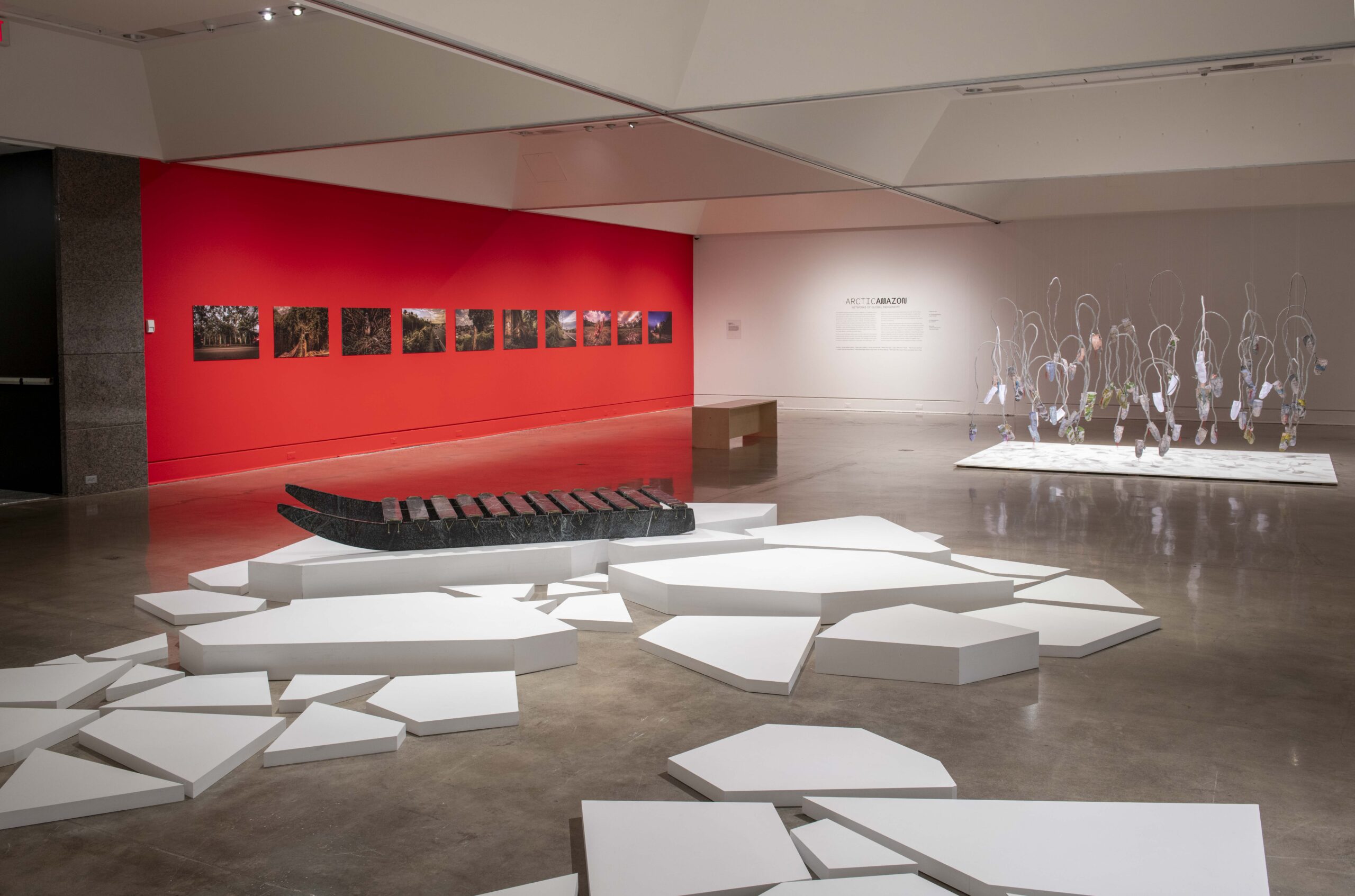Arctic/Amazon: A Call to Action

Arctic Amazon: Networks of Global Indigeneity is as engaging as it is improbable. The new exhibition at AGNS focusses on two parts of the world that remain mysterious for most of the global population, whether in the south or the north: Amazonia, and the circumpolar Arctic. Steaming jungle and frozen tundra, dense rainforests and seemingly endless snow and ice fields. The two landscapes could not be more different. As the exhibition’s lead curator Gerald McMaster says, the exhibition “brings together artists from two regions of the world that you would think are totally unconnected.” The connections are there, of course, brought to the forefront in this exhibition of 17 artists co-crated by McMaster, a Plains Cree artist, curator and educator, and Nina Vincent, a Brazilian anthropologist and curator. The connections are myriad: climate change (“melting ice in the Arctic, raging fires in the Amazon,” says McMaster), colonialism, oppression, language, tradition, and much more. “The artists are the ones today who speak to the issues,” McMaster says, “but they are talking about the culture itself and how strong it is, despite centuries of erasure by governments.”
The exhibition grew out of a symposium held in Toronto in 2019, co-hosted by OCAD University (where McMaster runs the Wapateh Centre for Indigenous Visual Knowledge), and the Power Plant, where the exhibition was first mounted. Its roots, however, go much deeper, to an idea McMaster had to do an exhibition of Arctic artists and Australian Aboriginal artists. Over time, as collaborators came on board and opportunities presented themselves, Arctic Amazon evolved. Launched in 2020 in Toronto at the Power Plant, the exhibition was soon shut down by the Covid-19 pandemic. Now, finally, it is in Halifax.
The exhibition is installed across two floors of the AGNS, split between Gallery 1 on the lower level, and across the third floor of Gallery North. Each section of the exhibition is installed to maximise the advantages of the galleries. In Gallery 1, with its large open space and long walls, large-scale works by Couzyn van Heuvelen, Sonya Kelliher-Combs, Uýra, and the collective works of Olinda Reshinjabe, Wilma Maynas, and Ronin Koshi are given space to breathe, and to envelop the viewer. Photographs, paintings, sculpture and textile works all hold the room in equilibrium, and as a viewer you move easily from work to work, experience to experience.
Couzyn van Heuvelen’s Qamutiik (2019) sits in the centre of the gallery space. A “qamutiik” is a traditional Inuit wooden sled (van Heuvelen is an Inuit artist who was born in Iqaluit and now lives in Southern Ontario). These are familiar tools in the Arctic. Here, however, the sled is made from black soapstone, van Heuvelen’s clever homage to the work of earlier Inuit artists who carved sculptures out of this material. The work is displayed on a series of geometric white forms, evoking a melting icefield. There is a sense of eco-anxiety here, we imagine the stone sled will sink if its ice support melts, and the ice is certainly melting in van Heuvelen’s home. But there is humour as well. At the press reception for the exhibition he told a story of hearing a notice on community radio in Iqaluit of a qamutiik being seen floating away on an ice floe. He doesn’t know if that one was recovered.
Sonya Kelliher-Combs harrowing work Idiot Strings: Credible (2022) addresses the historical abuse of Inuit children in schools run by the Catholic Church in Alaska. The work is comprised of 35 pouches sewn from printed fabric, printed with maps of each community where it has been found that there is a “credible claim” of abuse by Church members. Each pouch is connected to another, and held up by steel wires, representing the “idiot strings” attached to mittens so they will not be lost. Idiot Strings: Credible insists that the truth of the sexual and other abuse suffered by generations of young Inuit in Alaskan church schools will not be lost either.
The third floor galleries feature drawings, photographs, video installation and sculpture. The floor’s series of linked rooms allow for works to be installed to maximise the impact of video projections in particular, and visitors should be prepared to spend some time in the galleries. Repeat visits will be repaid by new discoveries.
As AGNS Interim Director and CEO Sarah Moore Fillmore says, Arctic Amazon is“a clear demonstration that art, activism, and traditional knowledge can act as a catalyst for global conversations amid tumultuous environmental and political times.” This exhibition, indeed, is a call for action. “We cannot have choice if we don’t have the right to be cold,” Kelliher-Combs poignantly says, “if our homeland and culture are destroyed by climate change.” Generous and urgent, the artists in this exhibition challenge us to respect the environment. To listen to traditional teachings. To make room for the peoples our material culture has displaced. Gerald McMaster puts it succinctly: “The right to be cold… the right to be taken care of by the forest… These are the rallying cries of our brothers and sisters, be they human, animal, or other.” Arctic Amazon compellingly urges us to listen.
Arctic Amazon: Networks of Global Indigeneity is on view until September 17, 2023.
Ray Cronin is a Nova Scotia-based writer, curator, and editor. He is the founding curator of the Sobey Art Award, and former Director and CEO of the Art Gallery of Nova Scotia. The author of eleven books on Canadian art, he regularly contributes to Canadian and American magazines, and frequently writes for gallery exhibition catalogues.

